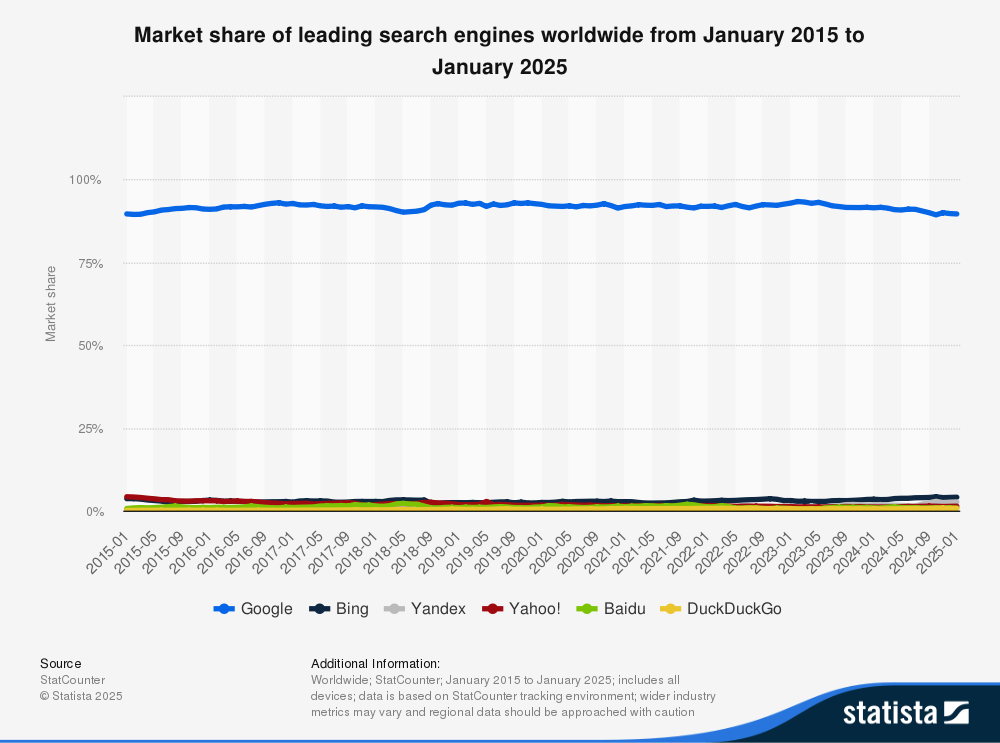The past year has monumentally shifted how we interact with the internet. From the meteoric rise of generative AI to landmark legal rulings against Google, the digital landscape is fundamentally being reshaped.
But these changes mark more than just technological and legal milestones. They’re a springboard for what will define the internet for years to come.
As AI continues to redefine online experiences, the future of the internet depends on the interplay between AI dominance and the increasing fragmentation of digital ecosystems. Brands must understand these shifts and anticipate potential scenarios to ensure they can connect with consumers long term.
To help make sense of this complex new environment, let’s dive into three emerging market scenarios and discuss how brands can proactively prepare for them, even in the face of uncertainty.
Potential Future #1: Google Dominance With AI Overviews
There’s no question that generative AI tools like Perplexity and ChatGPT have disrupted the status quo. However, Google continues to hold what these companies can only aspire to achieve — market dominance.
By and large, consumers still trust Google the most, as the search giant controls more than 89% of search engine market share.

Rather than launching a standalone chat platform, Google has strategically integrated its generative AI technology, Gemini, across its widely used suite of services. This approach has strengthened its position by creating a seamless, closed-loop ecosystem that keeps users firmly within its orbit.
This is reflected most prominently in Google’s search engine results pages (SERPs), where more than a billion global active users are already being exposed to generative AI search results through Google's AI Overviews.
A highly plausible future is one where this trend persists, with Google easily adapting to emerging tech and maintaining its strong market share.
The Implication for Brands
While consumer reliance on Google may remain consistent, the way users interact within Google’s ecosystem will inevitably evolve — significantly influencing how people discover and engage with brand websites (something which we’ve already found to be happening).
In this scenario, brands should prioritize developing a generative engine optimization (GEO) strategy to complement and scale alongside their traditional search engine optimization (SEO) efforts. GEO will help brands ensure results about them remain relevant and correct at the top of the SERP.
By optimizing for generative AI models, brands can ensure their messaging is included in AI Overviews, maintain visibility and continue to effectively influence consumer decision-making.
Related Article: The Impact of Generative AI on Traditional Search Engines: A Deep Dive Into OpenAI’s SearchGPT
Potential Future #2: OpenAI Dominance
Another potential scenario hinges on the continued rise of OpenAI platforms and models like the GPT series and DALL-E. With their continued support in funding rounds, OpenAI’s tools and infrastructure could become integral to how businesses, developers and consumers interact with the internet, remaking the digital landscape in its image.
In this market future, OpenAI’s conversational AI tools, like ChatGPT and SearchGPT, become the first destination for internet users. To OpenAI’s credit, these tools provide streamlined, highly contextual responses that offer an easy-to-use alternative for gathering information and making decisions.
Collaborations with Microsoft, startups and enterprises may further amplify OpenAI’s influence. These partnerships would serve to embed OpenAI’s technology into enterprise-level solutions, ensuring its presence in both consumer and business-facing applications.
The Implication for Brands
Brands must closely monitor OpenAI’s evolution, embrace innovation and explore new ways to measure and report their visibility in and impact on its tools.
Unlike traditional search engines, OpenAI does not provide information about consumer behavior in publicly available endpoints or datasets. This lack of transparency would make it difficult to measure the impact of brand marketing efforts, so brands would need to explore new approaches to track engagement and optimize their strategies.
Investment in GEO within OpenAI then becomes incredibly important, and SEO strategies as we know them now may no longer suffice.
Since ChatGPT relies on Bing as a primary data source (rather than Google), ranking well on Bing could become more critical for brands looking to remain visible. Unlike Google’s focus on its closed-loop ecosystem, Bing’s integration with OpenAI positions it as a key player in generative AI-powered search experiences. That is, for now — as OpenAI moves to a for-profit model, we might see them move away from Bing in the near future.
Potential Future #3: Fragmentation of the Internet (The Most Likely Scenario)
Our third scenario is the one I believe to be most likely: the eventual fragmentation of the internet. This means user behavior is dispersed across multiple channels, including traditional search engines, generative AI platforms, social media, individual websites and more.
As users grow more comfortable with generative AI, it’s likely they won’t fully rely on one emerging platform but instead adopt a multimodal approach, engaging with a mix of tools and platforms to meet their needs. This diversification of user touchpoints creates a more complex landscape for brands to navigate.
We may also see increased regulatory scrutiny and constraints on major AI providers that will, in turn, promote more diverse solutions. Policies designed to encourage competition and protect consumer privacy inadvertently drive fragmentation by limiting the dominance of any one platform, contributing to a fractured ecosystem.
Smaller, more regional players such as China’s Baidu and Europe’s Gaia-X are already building localized AI ecosystems that cater to specific markets and regulatory environments. These alternatives may influence global behavior by further dividing user behavior across different systems and standards.
Implications for Brands
Fragmentation fuels competition among tech giants, spurring innovation in AI-driven tools and platforms. In this future, brands will have more opportunities to experiment with customized strategies to engage audiences.
And they’ll need to. With users interacting across various platforms, consumer behavior data will become more siloed. Consistent messaging and experiences that resonate across multiple touchpoints will become even more important than they are now.
In a fragmented internet, significantly relying on one strategy like SEO will not be enough. Brands will need to diversify their data sources to optimize for both generative AI tools (through GEO) and non-search channels like social media and direct website engagement.
A multi-channel approach will be critical to maintaining visibility and relevance in this scattered digital landscape.
Related Article: 5 Ways AI Can Impact and Improve Your Search Strategy
Planning for the Unknown
Although the future remains uncertain, what we do know is the internet will continue to evolve, shaped by competition, innovation and regulation.
In this dynamic landscape, businesses and leaders must remain agile, strategically adopt AI technologies, invest in upskilling their teams and prioritize ethical AI practices.
Proactive planning and adapting for the long term will ease these shifts and allow leading brands to stay ahead no matter which scenario plays out.
Learn how you can join our contributor community.
